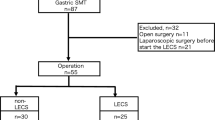Abstract
Introduction and aims
PEG removal in head and neck cancer patients (HNCPs) is performed after treatment, in case of disease remission and after adequate oral intake is resumed. The PEG tract usually closes spontaneously within 2–3 days. Persistent gastrocutaneous fistula (GCF) is a rare complication after PEG tube removal and is characterized by the persistence of gastric leakage through the fistulous tract for more than 1 month. Our main goal was to access the incidence and the success of a treatment algorithm for GCF in HNCPs.
Methods
Retrospective unicentric study of HNCPs referred for PEG removal between 2014 and 2018. The patients with GCF were selected and their sequential treatment was reviewed.
Results
In 331 patients with PEGs removed, 19 (5.7%) GCFs were documented. Medical therapy (4–8 weeks) was performed with clinical success (definitive closure of the GCF) in 12 (63.2%) patients. The remaining seven patients required endoscopic or surgical treatment. In four, endoscopic treatment had technical and clinical success (in three patients with fulguration of the gastric leak edges with argon plasma coagulation, silver nitrate in the path and external orifice, and closure of the internal orifice with hemoclips and in one with an over-the-scope-clip). Only three patients underwent surgery, one due to clinical failure of sequential endoscopic therapy and two had direct surgery.
Conclusion
GCF occurs rarely after PEG removal in HNCPs. Medical therapy is usually effective and should be maintained for at least 8 weeks. Endoscopic therapy is an effective second-line option with and surgery rarely required.



Similar content being viewed by others
Data availability
The authors confirm that the data supporting the findings of the study are available within the article.
References
Hausmann J, Kubesch A, Grun JM, Goettlich CM (2019) Prophylactic percutaneous endoscopic gastrostomy in patients with head and neck cancer: influence on nutritional status, utilization rate and complications. Int J Clinical Practice 17(7):201–207
Tracey A, Janik R, Joseph S, Landholm H, Landholm J (2004) Analysis of factors affecting the spontaneous closure of a gastrocutaneous fistula. J Pediatric Surg 39:1197–1199
Peter S, Geyer M, Beglinger C (2006) Persistent gastrocutaneous fistula after percutaneous gastrostomy tube removal. Endoscopy 36:700–704
Heinrich H, Gubler C, Valli P (2017) Over-the-scope-clip closure of long lasting gastrocutaneous fistula after percutaneous endoscopic gastrostomy tube removal in immunocompromised patients: a single center case series. World J Gastrenterol 9(2):85–90
Tang S (2014) Endoscopic management of gastrocutaneous fistula using clipping, suturing, and plugging methods. J Encycl GI Endosc 2:55–60
Deen OJ, Parisian KR, Harris C, Kirby D (2013) A novel procedure for gastrocutaneous fistula closure. J Clin Gastroentl Endosc 47(7):608–611
Jaramillo J, Hyun J, Abrajano C, Koppolu R (2016) Salvage of a failed open gastrocutaneous fistula repair with an endoscopic over-the-scope clip. J Ped Surg Case Rep 8:40–41
Gauderer MW, Ponsky JL, Izant RJ (1980) Gastrostomy without laparotomy: a percutaneous endoscopic technique. J Pediatr Surg 15:872–877
Funding
The authors received no financial support for the research, authorship or publication of this article.
Author information
Authors and Affiliations
Contributions
SF: conception of the study; SF: expert endoscopists; SF, PC, FF: data analysis; PC: statistical analysis and manuscript draft; SF and DP: critical review of the manuscript.
Corresponding author
Ethics declarations
Disclosures
The authors Pedro Currais, Sandra Faias, Fátima Francisco, Liliana Sousa, Joana Gramacho, and António Dias Pereira have no conflicts of interest or financial ties to disclose.
Additional information
Publisher's Note
Springer Nature remains neutral with regard to jurisdictional claims in published maps and institutional affiliations.
Rights and permissions
About this article
Cite this article
Currais, P., Faias, S., Francisco, F. et al. Gastrocutaneous fistulas after PEG removal in adult cancer patients: frequency and treatment options. Surg Endosc 35, 2211–2216 (2021). https://doi.org/10.1007/s00464-020-07627-z
Received:
Accepted:
Published:
Issue Date:
DOI: https://doi.org/10.1007/s00464-020-07627-z




